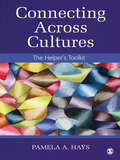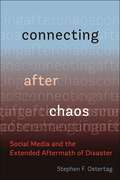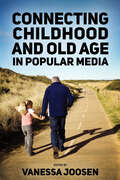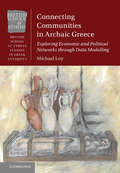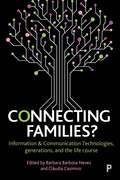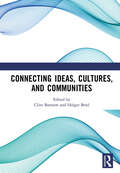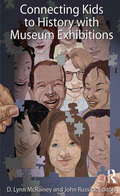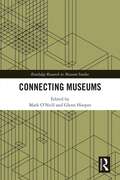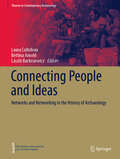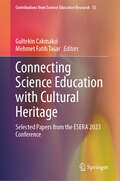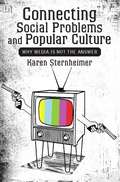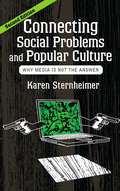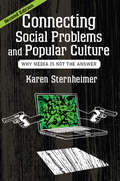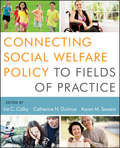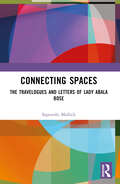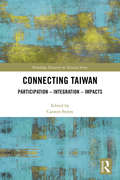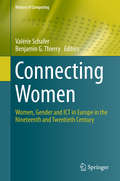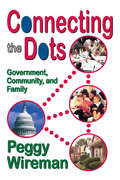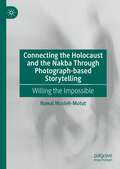- Table View
- List View
Connecting Across Cultures: The Helper′s Toolkit
by Pamela A. HaysChock-full of fun exercises, surprising tips, and real-world case examples, Connecting Across Cultures: The Helper′s Toolkit provides both students and professionals in health care, education, and social services with the skills to develop respectful, smooth relationships with clients and the community at large. The book offers communication tools to defuse defensive interactions, resolve conflicts constructively, and engage respectfully. Written in a warm, inviting style, the author shares her own mistakes as she explains what not to do and how to do it better. The book provides practical, hands-on strategies for connecting with people across differences related to ethnicity, religion, nationality, sexual orientation, disability, age, gender, and class. Because cross-cultural relationships involve extra challenges, this book will help you with almost every relationship you encounter.
Connecting Across Cultures: The Helper′s Toolkit
by Pamela A. HaysChock-full of fun exercises, surprising tips, and real-world case examples, Connecting Across Cultures: The Helper′s Toolkit provides both students and professionals in health care, education, and social services with the skills to develop respectful, smooth relationships with clients and the community at large. The book offers communication tools to defuse defensive interactions, resolve conflicts constructively, and engage respectfully. Written in a warm, inviting style, the author shares her own mistakes as she explains what not to do and how to do it better. The book provides practical, hands-on strategies for connecting with people across differences related to ethnicity, religion, nationality, sexual orientation, disability, age, gender, and class. Because cross-cultural relationships involve extra challenges, this book will help you with almost every relationship you encounter.
Connecting After Chaos: Social Media and the Extended Aftermath of Disaster
by Stephen F. OstertagA riveting portrait of how one community used the power of culture to restore their lives and socialconnections in the years after a devastating natural disasterNatural disasters and other such catastrophes typically attract large-scale media attention and public concern in their immediate aftermath. However, rebuilding efforts can take years or even decades, and communities are often left to repair physical and psychological damage on their own once public sympathy fades away. Connecting After Chaos tells the story of how people restored their lives and society in the months and years after disaster, focusing on how New Orleanians used social media to cope with trauma following Hurricane Katrina.Stephen F. Ostertag draws on almost a decade of research to create a vivid portrait of life in “settling times,” a term he defines as a distinct social condition of prolonged insecurity and uncertainty after disasters. He portrays this precarious state through the story of how a group of strangers began blogging in the wake of Katrina, and how they used those blogs to put their lives and their city back together. In the face of institutional failure, weak authority figures, and an abundance of chaos, the people of New Orleans used social media to gain information, foster camaraderie, build support networks, advocate for and against proposed policies, and cope with trauma. In the efforts of these bloggers, Ostertag finds evidence of the capacity of this and other forms of cultural work to motivate, guide, and energize collective action aimed at weathering the constant instability of extended recovery periods. Connecting After Chaos is both a compelling story of a community in crisis and a broader argument for the power of social media and cultural cooperation to create order when chaos abounds.
Connecting Childhood and Old Age in Popular Media
by Vanessa JoosenContributions by Gökçe Elif Baykal, Lincoln Geraghty, Verónica Gottau, Vanessa Joosen, Sung-Ae Lee, Cecilia Lindgren, Mayako Murai, Emily Murphy, Mariano Narodowski, Johanna Sjöberg, Anna Sparrman, Ingrid Tomkowiak, Helma van Lierop-Debrauwer, Ilgim Veryeri Alaca, and Elisabeth Wesseling Media narratives in popular culture often assign interchangeable characteristics to childhood and old age, presuming a resemblance between children and the elderly. These designations in media can have far-reaching repercussions in shaping not only language, but also cognitive activity and behavior. The meaning attached to biological, numerical age—even the mere fact that we calculate a numerical age at all—is culturally determined, as is the way people “act their age.” With populations aging all around the world, awareness of intergenerational relationships and associations surrounding old age is becoming urgent. Connecting Childhood and Old Age in Popular Media caters to this urgency and contributes to age literacy by supplying insights into the connection between childhood and senescence to show that people are aged by culture. Treating classic stories like the Brothers Grimm's fairy tales and Heidi; pop culture hits like The Simpsons and Mad Men; and international productions, such as Turkish television cartoons and South Korean films, contributors explore the recurrent idea that “children are like old people,” as well as other relationships between children and elderly characters as constructed in literature and media from the mid-nineteenth century to the present. This volume deals with fiction and analyzes language as well as verbally sparse, visual productions, including children's literature, film, television, animation, and advertising.
Connecting Communities in Archaic Greece: Exploring Economic and Political Networks through Data Modelling (British School at Athens Studies in Greek Antiquity)
by Michael LoyThis is a new history of Greece in the seventh and sixth centuries BC written for the twenty-first century. It brings together archaeological data from over 100 years of 'Big Dig' excavation in Greece, employing experimental data analysis techniques from the digital humanities to identify new patterns about Archaic Greece. By modelling trade routes, political alliances, and the formation of personal- and state-networks, the book sheds new light on how exactly the early communities of the Aegean basin were plugged into one another. Returning to the long-debated question of 'what is a polis?', this study also challenges Classical Archaeology more generally: that the discipline has at its fingertips significant datasets that can contribute to substantive historical debate -and that what can be done for the next generation of scholarship is to re-engage with old material in a new way.
Connecting Families?: Information & Communication Technologies, Generations, and the Life Course
by Barbara Barbosa Neves and Cláudia CasimiroAre Information and Communication Technologies (ICTs) connecting families? And what does this mean in terms of family routines, relationships, norms, work, intimacy and privacy? This edited collection takes a life course and generational perspective covering theory, including posthumanism and strong structuration theory, and methodology, including digital and cross-disciplinary methods. It presents a series of case studies on topics such as intergenerational connections, work-life balance, transnational families, digital storytelling and mobile parenting. It will give students, researchers and practitioners a variety of tools to make sense of how ICTs are used, appropriated and domesticated in family life. These tools allow for an informed and critical understanding of ICTs and family dynamics.
Connecting Histories
by RomainFirst published in 2006. Routledge is an imprint of Taylor & Francis, an informa company.
Connecting Ideas, Cultures, and Communities: Proceedings of the Second International Symposium on Humanities and Social Sciences (ISHSS, 2024), Macau, China, August 16th–18th, 2024
by Holger Briel Clive BarstowThe proceedings of the Second International Symposium on Humanities and Social Sciences (ISHSS 2024), provide a rich repository of scholarly articles that explore the intricate links between ideas, cultures, and communities. This volume captures the essence of interdisciplinary research, offering fresh perspectives on the challenges and opportunities within the social sciences. Spanning a wide array of topics, from historical analysis to contemporary sociological studies, the proceedings delve into the main findings of the symposium. With a focus on regional development, political policies, and the impact of technology on education, these papers illustrate a commitment to advancing understanding and fostering global dialogue.Designed for academics, researchers, and professionals in the fields of humanities and social sciences, this publication is ideal for those seeking to expand their knowledge, engage with current research, and contribute to the ongoing discourse on the pressing issues of our time.
Connecting International Law with Public Law: The Public Law of Gender
by Kim Rubenstein Rubenstein, Kim and Young, Katharine G. Katharine G. YoungWith the worldwide sweep of gender-neutral, gender-equal or gender-sensitive public laws in international treaties, national constitutions and statutes, it is timely to document the raft of legal reform and to critically analyse its effectiveness. In demarcating the academic study of the public law of gender, this book brings together leading lawyers, political scientists, historians and philosophers to examine law's structuring of politics, governing and gender in a new global frame. Of interest to constitutional and statutory designers, advocates, adjudicators and scholars, the contributions explore how concepts such as equality, accountability, representation, participation and rights, depend on, challenge or enlist gendered roles and/or categories. These enquiries suggest that the new public law of gender must confront the lapses in enforcement, sincerity and coverage that are common in both national and international law and governance, and critically and pluralistically recast the public/private distinction in family, community, religion, customary and market domains.
Connecting Kids to History with Museum Exhibitions
by D. Lynn McRainey John RussickKids have profound and important relationships to the past, but they don't experience history in the same way as adults. For museum professionals and everyone involved in informal history education and exhibition design, this book is the essential new guide to creating meaningful and memorable connections to the past for children. This vital museum audience possesses many of the same dynamic qualities as trained historian—curiosity, inquiry, empathy for the human experience—yet traditional history exhibitions tend to focus on passive looking in the galleries, giving priority to relaying information through words. D. Lynn McRainey and John Russick bring together top museum professionals to present state-of-the-art research and practice that respects and incorporates kids' developmental stages and learning preferences and the specific ways in which kids connect to history. They provide concrete tools for audience research and evaluation; exhibition development and design; and working with kids as "creative consultants." The only book to focus comprehensively on history exhibits for kids, Connecting Kids to History With Museum Exhibitions shows how to enhance the experiences of a vitally important but frequently the least understood museum audience.
Connecting Museums (Routledge Research in Museum Studies)
by Glenn Hooper Mark O'NeillConnecting Museums explores the boundaries of museums and how external relationships are affected by internal commitments, structures and traditions. Focusing on museums’ relationship with heath, inclusion, and community, the book provides a detailed assessment of the alliances between museums and other stakeholders in recent years. With contributions from practitioners and established and early-career academics, this volume explore the ideas and practices through which museums are seeking to move beyond what might be called one-off contributions to society, to reach places where the museum is dynamic and facilitates self-generation and renewal, where it can become not just a provider of a cultural service, but an active participant in the rehabilitation of social trust and democratic participation. The contributors to this volume provide conceptual critiques and clarification of a number of key ideas which form the basis of the ethics of museum legitimacy, as well as a number of reports from the front line about the experience of trying to renew museums as more valuable and more relevant institutions. Providing internal and external perspectives, Connecting Museums presents a mix of applied and theoretical understandings of the changing roles of museums today. As such, the book should be of interest to academics, researchers and students working in the broad fields of museum and heritage studies, material culture, and arts and museum management.
Connecting People and Ideas: Networks and Networking in the History of Archaeology (Themes in Contemporary Archaeology)
by László Bartosiewicz Bettina Arnold Laura ColtofeanThis book presents new research into social networks and the various networking modes that formed during the history of archaeology in distinct geographical settings in Europe, North America, and South Asia in the nineteenth and twentieth centuries. The diverse range of international experts in this edited collection demonstrate that networks can be found everywhere in archaeology, making it a highly interconnected research field. Using a wide array of examples from diverse geopolitical, cultural, and social contexts, the volume reveals how essential social networks and networking have been to the development of archaeology; to the production, transfer, exchange, and dissemination of archaeological and cross-disciplinary knowledge; and to the formation, upward mobility, barrier transcendence, research, and association of archaeological practitioners. The book is of interest to students and scholars of history of archaeology, history of science, museum studies and interdisciplinary studies.
Connecting Science Education with Cultural Heritage: Selected Papers from the ESERA 2023 Conference (Contributions from Science Education Research #15)
by Gultekin Cakmakci Mehmet Fatih TasarThis edited volume presents groundbreaking research in science education, focusing on the intersection of science and cultural heritage. Showcasing 23 high-quality studies, it draws from presentations at the 15th Biennial ESERA Conference held in Cappadocia, Türkiye, organized by Hacettepe University, Gazi University, and Nevşehir Hacı Bektaş Veli University. Under the theme "Connecting Science Education with Cultural Heritage," the chapters offer fresh perspectives on advancing science education literature from diverse viewpoints. With contributions spanning continents, this book delivers an exceptional collection of international studies featuring original and rigorous methodologies. Scholars and researchers in science education will find this compilation an invaluable resource, making it a vital addition to academic libraries worldwide.
Connecting Social Problems and Popular Culture
by Karen SternheimerWhile popular culture receives a lot of attention as a central causal factor in contemporary social problems, Sternheimer (sociology, U. of Southern California) argues that in reality, although media does impact society, there are many more important factors contributing to America's serious social problems today. The author examines the history of media fears, who constructs media--and youth--phobia and why, and then analyzes a number of social problems--the dumbing down of America, family instability, violence, teen sex, teen pregnancy and single parenthood, the rising materialism of youth, eating disorders, substance abuse, misogyny, homophobia, and racism--and their causes. Annotation ©2009 Book News, Inc. , Portland, OR (booknews. com)
Connecting Social Problems and Popular Culture
by Karen SternheimerIs violence on the streets caused by violence in video games? Do hip-hop lyrics increase misogynistic and homophobic behavior? Are teens promiscuous because of what they see in movies? Popular culture is an easy answer for many of society's problems, but it is almost always the wrong answer. This innovative book goes beyond the news-grabbing headlines claiming that popular culture is public enemy number one to consider what really causes the social problems we are most concerned about. The sobering fact is that the roots of poverty, child abuse, and unequal public education are much more complicated than the media-made-them-do-it explanations. Karen Sternheimer deftly illustrates how welfare "reform," a two-tiered health care system, and other difficult systemic issues have far more to do with our contemporary social problems than Grand Theft Auto or 50 Cent.
Connecting Social Problems and Popular Culture
by Karen SternheimerIs violence on the streets caused by violence in video games? Do hip-hop lyrics increase misogynistic and homophobic behavior? Are teens promiscuous because of what they see in movies? Popular culture is an easy answer for many of society's problems, but it is almost always the wrong answer. This innovative book goes beyond the news-grabbing headlines claiming that popular culture is public enemy number one to consider what really causes the social problems we are most concerned about. The sobering fact is that the roots of poverty, child abuse, and unequal public education are much more complicated than the media-made-them-do-it explanations. Karen Sternheimer deftly illustrates how welfare "reform," a two-tiered health care system, and other difficult systemic issues have far more to do with our contemporary social problems than Grand Theft Auto or 50 Cent.
Connecting Social Problems and Popular Culture
by Karen SternheimerIs violence on the streets caused by violence in video games? Does cyber-bullying lead to an increase in suicide rates? Are teens promiscuous because of Teen Mom? As Karen Sternheimer clearly demonstrates, popular culture is an easy scapegoat for many of society’s problems, but it is almost always the wrong answer. Now in its second edition, Connecting Social Problems and Popular Culture goes beyond the news-grabbing headlines claiming that popular culture is public enemy number one to consider what really causes the social problems we are most concerned about. The sobering fact is that a "media made them do it" explanation fails to illuminate the roots of social problems like poverty, violence, and environmental degradation. Sternheimer’s analysis deftly illustrates how welfare "reform," a two-tiered health care system, and other difficult systemic issues have far more to do with our contemporary social problems than Grand Theft Auto or Facebook. The fully-revised new edition features recent moral panics--think sexting and cyberbullying--and an entirely new chapter exploring social media. Expanded discussion of how we understand society’s problems as social constructions without disregarding empirical evidence, as well as the cultural and structural issues underlying those ills, allows students to stretch their sociological imaginations.
Connecting Social Problems and Popular Culture
by Karen SternheimerIs violence on the streets caused by violence in video games? Does cyber-bullying lead to an increase in suicide rates? Are teens promiscuous because of Teen Mom? As Karen Sternheimer clearly demonstrates, popular culture is an easy scapegoat for many of society's problems, but it is almost always the wrong answer.Now in its second edition, this innovative book goes beyond the news-grabbing headlines claiming that popular culture is public enemy number one to consider what really causes the social problems we are most concerned about. The sobering fact is that a "media made them do it" explanation fails to illuminate the roots of social problems like poverty, violence, and environmental degradation. Sternheimer's analysis deftly illustrates how welfare "reform," a two-tiered health care system, and other difficult systemic issues have far more to do with our contemporary social problems than Grand Theft Auto or Facebook. The fully-revised new edition features recent moral panics-think sexting and cyberbullying-and an entirely new chapter exploring social media. Expanded discussion of how we understand society's problems as social constructions without disregarding empirical evidence, as well as the cultural and structural issues underlying those ills, allows students to stretch their sociological imaginations.
Connecting Social Problems and Popular Culture: Why Media is Not the Answer
by Karen SternheimerIs violence on the streets caused by violence in video games? Does cyber-bullying lead to an increase in suicide rates? Are teens promiscuous because of Teen Mom? As Karen Sternheimer clearly demonstrates, popular culture is an easy scapegoat for many of society's problems, but it is almost always the wrong answer.Now in its second edition, Connecting Social Problems and Popular Culture goes beyond the news-grabbing headlines claiming that popular culture is public enemy number one to consider what really causes the social problems we are most concerned about. The sobering fact is that a "media made them do it" explanation fails to illuminate the roots of social problems like poverty, violence, and environmental degradation. Sternheimer's analysis deftly illustrates how welfare "reform," a two-tiered health care system, and other difficult systemic issues have far more to do with our contemporary social problems than Grand Theft Auto or Facebook. The fully-revised new edition features recent moral panics?think sexting and cyberbullying?and an entirely new chapter exploring social media. Expanded discussion of how we understand society's problems as social constructions without disregarding empirical evidence, as well as the cultural and structural issues underlying those ills, allows students to stretch their sociological imaginations.
Connecting Social Welfare Policy to Fields of Practice
by Karen M. Sowers Catherine N. Dulmus Ira C. ColbyInvaluable guidance and advice for creating positive change in social policyEdited by a team of renowned experts, Connecting Social Welfare Policy to Fields of Practice features contributions from leaders in this field providing a variety of perspectives on different topics. This visionary guide equips social workers to proactively engage in policy practice to influence specific policies.Designed as a social welfare policy practice text for undergraduate and graduate students in social work programs, this book meets the Council on Social Work Education's (CSWE) Educational Policy and Accreditation Standards (EPAS).Each chapter begins with an overarching question and "what if" scenarios, and ends with a set of suggested key terms, online resources, and discussion questions.Connecting Social Welfare Policy to Fields of Practice addresses specific populations within a wide variety of practice arenas, including:Social welfare policy and politicsAging in the United StatesPublic mental health policy in the United StatesDisability policy developmentHealth-care policyUrban housing policyChild welfare policyRedefining the welfare state in a global economyGlobal in context, Connecting Social Welfare Policy to Fields of Practice encourages those in the social work profession to become directly engaged with individuals, families, groups, and communities in the crafting of impartial public policies for marginalized members of society.
Connecting Spaces: The Travelogues and Letters of Lady Abala Bose
by Saptarshi MallickThis book examines how nineteenth-century Bengal witnessed women writers like Krishnabhabini Devi, Prasanyamoyee Devi, Swarnakumari Devi and Abala Bose interrogated social stereotypes. It presents the first translation of travel writings and letters by Abala Bose, and examines an Indian woman’s close observation as she toured India in colonial times and Europe, America and Japan at the height of British imperialism. Her travelogues in colonial India and imperial England relate to and interrogate the hegemonic role of Western ideologies and deconstruct stereotypes of women’s travelogues, thus contributing to the female consciousness and tradition of women’s writings.The volume will be of great interest to scholars and researchers of South Asian history, imperial and colonial history, and gender and women's studies.
Connecting Taiwan: Participation – Integration – Impacts (Routledge Research on Taiwan Series)
by Carsten StormTaiwan has often been characterised as an isolated society in its search for sovereignty and security. Its contact with the world in an era of globalization and post-modernity, however, has increasingly led to Taiwanese actors successfully participating in many regional and global fields. In this book an international team of scholars presents cases studies and theoretical debates emphasising agency in coping with the effects of globalisation. In so doing, they contest the image of Taiwan’s marginalization and seek to understand it in terms of its connectedness, whether globally, regionally or trans-nationally. Taking a multi-disciplinary, comparative approach, it covers themes such as markets and trading, diplomacy and nation-branding, collective action, media, film and literature, and religious mission. It thus combines perspectives from several disciplines including media studies, sociology, political science, and studies in religion. Using Taiwan as an example of how to conceptualise connectivity and think differently about comparative studies, this book will be useful for students and scholars of Asian Politics and Cultural Studies, as well as of Taiwan Studies more specifically.
Connecting Women: Women, Gender and ICT in Europe in the Nineteenth and Twentieth Century (History of Computing)
by Valérie Schafer Benjamin G. ThierryThis important volume examines European perspectives on the historical relations that women have maintained with information and communication technologies (ICTs), since the telegraph. Features: describes how gendered networks have formed around ICT since the late 19th Century; reviews the gendered issues revealed by the conflict between the actress Ms Sylviac and the French telephone administration in 1904, or by 'feminine' blogs; examines how gender representations, age categories, and uses of ICT interact and are mutually formed in children's magazines; illuminates the participation of women in the early days of computing, through a case study on the Rothamsted Statistics Department; presents a comparative study of women in computing in France, Finland and the UK, revealing similar gender divisions within the ICT professions of these countries; discusses diversity interventions and the part that history could (and should) play to ensure women do not take second place in specific occupational sectors.
Connecting the Dots: Government, Community, and Family
by Peggy WiremanDespite its size and social diversity, the United States is one nation, and what happens in one city or neighborhood ultimately affects all Americans. "Connecting the Dots" addresses the complex relationships between family and community, and between community and other players affecting family and community life, including the private sector, government, nonprofit groups, and religious organizations. Contrary to much rhetoric, Wireman argues that America does not suffer from a loss of family values, but from a shift in business practices and public commitments. The American dream of work hard, buy a home, and give your children a better life is no longer realistic for millions of workers, both white-collar and blue-collar. At an individual level, millions of Americans face significant challenges as they go about trying to meet the everyday responsibilities of earning an income, feeding their families, maintaining their health, finding housing, handling everyday household chores, and caring for their children. Besides identifying top-down structures, laws, and attitudes that create a supportive context for family life, the book includes bottom-up anecdotal examples to ground its policy-oriented discussion. It also provides statistical data needed to develop realistic solutions. Wireman examines diversity as well, since how America handles racial and ethnic differences remains crucial to its future. She discusses ways in which communities have created social capital, community cohesion, and local organizational ability. Wireman provides a framework for policymakers, local community leaders, and neighborhood activists to use in analyzing their situations and selecting the best approach; she also describes what various players can and must do to uphold the American dream. "Connecting the Dots" will be of keen interest to sociologists, political scientists, economists, and social workers.
Connecting the Holocaust and the Nakba Through Photograph-based Storytelling: Willing the Impossible
by Nawal Musleh-MotutThis unprecedented ethnographic study introduces a unique photography-based storytelling method that brings together everyday Palestinians and Israelis to begin connecting rather than comparing their distinct yet organically connected histories of suffering and exile resulting from the Holocaust and the Nakba. Working with Palestinians and Israelis living in their respective Canadian diasporas who are of the Holocaust and Nakba postmemory generations–those who did not experience these traumas but are nonetheless haunted by them–this study demonstrates that storytelling and photography enable the occasions and conditions of possibility necessary for willing the impossible. That is, by narrating and then exchanging their (post)memories of the Holocaust and/or the Nakba through associated vernacular photographs, project participants were able to connect rather than compare their histories of suffering and exile; take moral, ethical, and political responsibility for one another; and imagine new forms of cohabitation grounded in justice and equitable rights for all.
